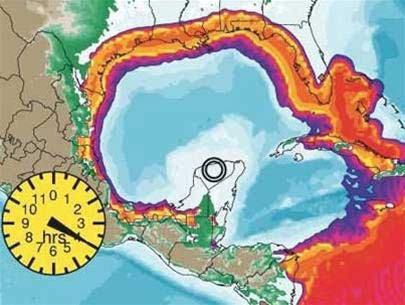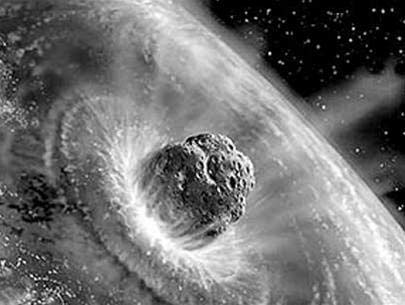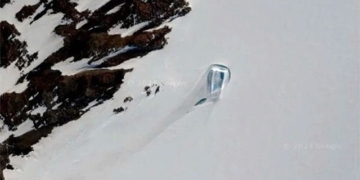Mark Sunday, April 13, 2036, on your calendar. This is the date when the asteroid Apophis may collide with Earth – a collision powerful enough to wipe out a small nation. The best hope: the chance of this collision currently stands at 1 in 6,250, and humanity still has the ability to intervene!
As of now, according to NASA (the National Aeronautics and Space Administration), Apophis – approximately 305 meters in diameter – is the most threatening asteroid to humanity. A collision with Apophis in an urban area could cause damage equivalent to the combined destruction of Hurricane Katrina, the 2004 Indian Ocean tsunami, and the 1906 earthquake in San Francisco.
 |
|
The model of the asteroid impact that is believed to have caused the extinction of the dinosaurs. The image shows a tsunami rising four hours after a 10-kilometer diameter asteroid struck. (Image: New Scientist) |
The explosive power of the asteroid is equivalent to 880 tons of TNT, which is 65,000 times greater than the devastation caused by the atomic bomb dropped on Hiroshima! Apophis (named after the Egyptian god of chaos and destruction) was discovered by scientists R. A. Tucker, D. J. Tholen, and F. Bernardi at the Kitt Peak Observatory in 2004.
In 1998, U.S. lawmakers ordered NASA to identify at least 90% of asteroids larger than 1 kilometer that are on a periodic trajectory crossing Earth’s path. To date, scientists have completed approximately three-quarters of this search.
Higher Likelihood of Ocean Impact
According to research by scientists Steve Chesley (from the Jet Propulsion Laboratory in Pasadena) and Steve Ward (from the University of California, Santa Cruz), the likelihood of an asteroid falling into the ocean is considered the greatest, as land only accounts for less than one-third of Earth’s surface. Chesley and Ward studied objects with diameters ranging from 60 to 400 meters impacting Earth.
If it were to fall into the ocean, smaller asteroids could create waves up to 10 meters high upon reaching shore. The 50 million coastal residents around the world could theoretically be affected by these waves.
With an occurrence rate of approximately every 6,000 years, a 300-meter asteroid could generate a tsunami larger than the 2004 Indian Ocean tsunami. Furthermore, they could eject a massive amount of water vapor into the atmosphere, hindering the Sun’s ability to warm the planet. According to one hypothesis, such an event 65 million years ago led to the extinction of the dinosaurs.
 |
|
(Image: New Scientist) |
On Land
If the asteroid were to fall on land, the destruction would depend on where this uninvited “guest” lands. The economic loss from such an event is estimated to be around $110 billion.
In response to a request from the U.S. Congress, NASA has compiled a list of asteroids capable of impacting Earth. The most recent object of concern is an 800-meter diameter asteroid named HZ51 2006, predicted to collide with Earth in two years.
According to experts from the B612 Foundation (which monitors hazardous space objects, named in honor of an asteroid mentioned in “The Little Prince”), the two-year timeframe is insufficient to adjust the object’s trajectory with current technology. (Changing its trajectory would require decades). However, HZ51 has since been removed from the list, as experts calculated that it is unlikely to collide with Earth.
Now, with Apophis, astronauts Ed Lu and Stanley Love have proposed that NASA establish a special fund to prevent a “foretold death” in 2036. However, how this asteroid will change its trajectory can only be determined no sooner than April 13, 2029.
That will be the moment when the distance between Apophis and Earth can be measured accurately during their first close encounter (closer than any telecommunications satellites). The two astronauts have suggested sending sensors to the asteroid to gather more information about this space threat. If the threat is real, the next step would be to intervene to alter the asteroid’s trajectory: by using lasers from the Moon or nuclear weapons!
TRAN DUC THANH


















































